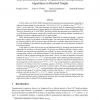Free Online Productivity Tools
i2Speak
i2Symbol
i2OCR
iTex2Img
iWeb2Print
iWeb2Shot
i2Type
iPdf2Split
iPdf2Merge
i2Bopomofo
i2Arabic
i2Style
i2Image
i2PDF
iLatex2Rtf
Sci2ools
84
Voted
STACS
2010
Springer
2010
Springer
Beyond Bidimensionality: Parameterized Subexponential Algorithms on Directed Graphs
In 2000 Alber et al. [SWAT 2000 ] obtained the first parameterized subexponential algorithm on undirected planar graphs by showing that k-DOMINATING SET is solvable in time 2O( √ k) nO(1) , where n is the input size. This result triggered an extensive study of parameterized problems on planar and more general classes of sparse graphs and culminated in the creation of Bidimensionality Theory by Demaine et al. [J. ACM 2005 ]. The theory utilizes deep theorems from Graph Minor Theory of Robertson and Seymour, and provides a simple criteria for checking whether a parameterized problem is solvable in subexponential time on sparse graphs. While bidimensionality theory is an algorithmic framework on undirected graphs, it remains unclear how to apply it to problems on directed graphs. The main reason is that Graph Minor Theory for directed graphs is still in a nascent stage and there are no suitable obstruction theorems so far. Even the analogue of treewidth for directed graphs is not uniq...
| Added | 14 May 2010 |
| Updated | 14 May 2010 |
| Type | Conference |
| Year | 2010 |
| Where | STACS |
| Authors | Frederic Dorn, Fedor V. Fomin, Daniel Lokshtanov, Venkatesh Raman, Saket Saurabh |
Comments (0)

